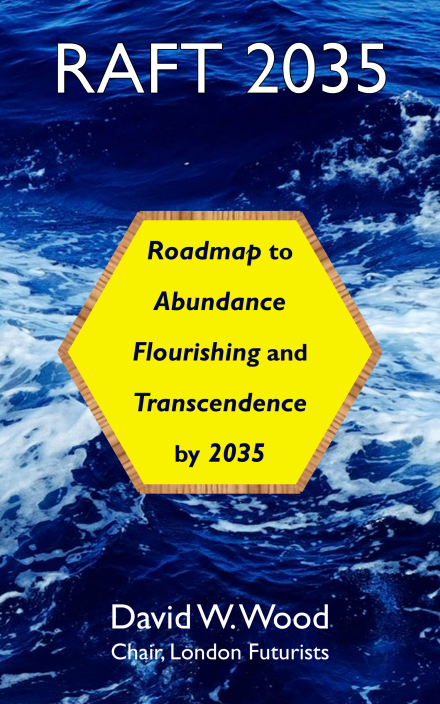This page contains the opening portion of Chapter 2 of RAFT 2035.
Copyright © 2020 David W. Wood. All rights reserved.
2. Mental wellbeing
Goal 2 of RAFT 2035 is that at least 99% of people in the UK will experience their mental health as “good” or “excellent”.

The statistics of people with mental health problems are collected and analysed every seven years by the Adult Psychiatric Morbidity Survey. Key findings from the most recent survey, which covered 2014, include the following:
- During the year in question, around one man in every eight, and around one woman in every five, experienced a mental health problem
- Young women have emerged as a high-risk group, with high rates of common mental disorders and self-harm.
Out of the population as a whole, the rates of people experiencing particular mental health issues include:
- 6% experienced suicidal thoughts at some time in their life
- 7% actually made a suicide attempt
- 3% harmed themselves
- 9% experienced generalised anxiety disorder
- 4% experienced PTSD (post traumatic stress disorder)
- 3% experienced antisocial personality disorder
- 4% experienced phobias
- 0% experienced bipolar disorder
- 3% experienced OCD (obsessive compulsive disorder).
In summary, far too many people nowadays suffer from deep depression, crippling anxiety, biting loneliness, distressing mood swings, and suicidal tendencies.
Harms caused by poor mental health
It may be argued that there are positive aspects to some of these psychological states – in other words, that it is wrong to classify so many people as having mental health problems. For example, some degree of stress and inner mental turmoil can be productive, in leading to positive personal transformation. However, in far too many cases, what people experience is stress that destroys character rather than builds it up.
Indeed, for men in England and Wales between the ages of 20 and 49, suicide is now the leading cause of death. The WHO has predicted that depression will be the single largest cause of disease burden worldwide by 2030. This is just the start of how poor mental health reduces the quality of human experiences.
Even when people don’t report themselves as being mentally ill, they often fall victim to herd mentality, wilful deception by others, and self-deception, as well as manipulation by commercial factors or other social pressures. We are too prone to what are known, in polite language, as “cognitive biases” – and in plain language, as collective stupidity. We are misled by fake news, by clever flattery, and by carefully targeted individualised communications that prey on hopes and fears of which we ourselves are only dimly aware. Despite having clever brains with access to huge amounts of information, we frequently use our intelligence unwisely, finding arguments that appear to justify us staying in our current mental ruts, and clinging to these arguments through thick and thin.
Poor mental health has consequences not only for individuals but for society as a whole. Ill-judged actions arising from disturbed mental processing worsen social strains. Indeed, mental ill-health often leads to behaviour that is fanatical, fundamentalist, criminal, or socially divisive, as well as self-harming.
With people having easier access to various sorts of “weapons of mass destruction”, the consequences of poor mental health become ever more serious.
It doesn’t have to be like this. Twenty first century understanding of the brain and mind suggests a number of steps that can be pursued.
Beyond normal mental wellbeing
Bringing many more people up to what might be called “normal mental wellbeing” is only the beginning of what could be achieved. As a comparison, that outcome would be similar to a programme of better physical health, that allowed more people to live to the age of 80 years. That would be a very laudable outcome, but it’s far short of what’s actually possible. As covered in the previous chapter, rejuvenation biotechnology has the potential to enable much greater physical health for all, well beyond the age of 80. This is sometimes summarised as living “better than well”.
As for physical health, so also for mental health. New technology has the potential to enable many more people to regularly reach levels of consciousness that previously were only occasionally reached, by a very small subset of the human population. These levels of consciousness involve deeper levels of calmness, compassion, connectedness, creativity, and much more.
<snip>

